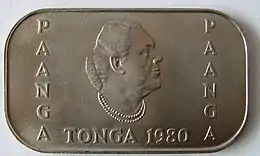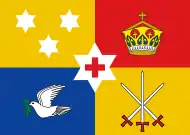| Sālote Tupou III | |||||
|---|---|---|---|---|---|
 Queen Salote in her coronation robe | |||||
| Queen of Tonga | |||||
| Reign | 5 April 1918 – 16 December 1965 | ||||
| Coronation | 11 October 1918, Nukuʻalofa | ||||
| Predecessor | George Tupou II | ||||
| Successor | Tāufaʻāhau Tupou IV | ||||
| Prime Ministers | See List
| ||||
| Born | 13 March 1900 Royal Palace, Tonga | ||||
| Died | 16 December 1965 (aged 65) Aotea Hospital, Auckland, New Zealand | ||||
| Burial | |||||
| Spouse | |||||
| Issue | Tāufaʻāhau Tupou IV Prince Uiliami Tuku‘aho Prince Fatafehi Tu'ipelehake | ||||
| |||||
| House | Tupou | ||||
| Father | George Tupou II | ||||
| Mother | Lavinia Veiongo | ||||
| Religion | Free Wesleyan Church | ||||
Sālote Tupou III (born Sālote Mafile‘o Pilolevu; 13 March 1900 – 16 December 1965) was Queen of Tonga from 1918 to her death in 1965. She reigned for nearly 48 years, longer than any other Tongan monarch. She was well known for her height, standing 6 ft 3 in (1.91 metres) tall in her prime.[1][2]
Early life

Sālote (Charlotte) was born on 13 March 1900 in Tonga as the eldest daughter and heir of King George Tupou II of Tonga and his first wife Queen Lavinia Veiongo.[3] She was baptized and named after her great-grandmother Sālote Mafile‘o Pilolevu (daughter of George Tupou I).[4] The young princess was the source of some hostility due to the nature of her parents' marriage.[5]
Her mother, Queen Lavinia, died from tuberculosis on 24 April 1902.[6] After her death, the Chiefs in Tonga urged King George Tupou II for many years to remarry to produce a male heir. On 11 November 1909, when the King finally married the 16-year-old ʻAnaseini Takipō (half-sister of the rejected candidate 'Ofakivava'u' from the first search of a wife for the King), the chiefs were jubilant. Queen Anaseni gave birth twice, both girls: Princess ʻOnelua (born 20 March 1911; died of convulsions aged six months, on 19 August 1911) and Princess ʻElisiva Fusipala Taukiʻonetuku (born 26 July 1912; died from tubercular peritonitis on 21 April 1933 aged 20).[7]
Tongan tradition allows offsprings from previous marriages to be killed. In order to protect her, the King sent Sālote away to Auckland in December 1909. She stayed with a family called Kronfeld and would maintain this connection throughout her life.[8]
Education
In December 1909, Sālote was sent to Auckland, New Zealand, to start five years of education.[9] She returned to Tonga every Christmas holiday.
In 1913, Sālote was sent to the Anglican Diocesan School for Girls, a boarding school in Epsom, New Zealand. She would study there for 2 years before being ordered to stay in Tonga. Although the King wanted Sālote to continue her education, the chiefs convinced him otherwise. Queen Takipō had not given birth to a son and hence according to the Constitution of 1875, after her fifteenth birthday, Sālote became the heir presumptive to the Tongan throne.[10]
Personal history
In 1917, Sālote married Viliami Tungī Mailefihi, an adult noble then 30 years old, 13 years her senior. At the age of 18, she became a mother for the first time. Her children were:
- Prince Siaosi Tāufaʻāhau Tupoulahi (4 July 1918 – 10 September 2006), later known as King Tāufa‘āhau Tupou IV,[11]
- Prince Uiliami Tuku‘aho (5 November 1919 – 28 April 1936), who died young,[11]
- Prince Sione Ngū Manumataongo (7 January 1922 – 10 April 1999), later known as 5th Tu'ipelehake (Fatafehi),[11]
- Three pregnancies ended in miscarriages.[12]
Sālote had a somewhat troubled medical history. She suffered from diabetes which required frequent visits to Auckland for treatment. An operation had to be conducted in 1935 to treat her cancer and during tests in Auckland in 1965 a second bout of cancer was found. Despite this the Queen returned to Tonga in May and even participated in a festival in July 1965 celebrating her record reign. 10,000 children were allowed to enter the palace grounds and wave at the Queen as she sat on the verandah. This would be the last time the Tongan people saw their Queen. Queen Sālote died peacefully on 16 December 1965 at 12:15 am. Her body was flown back to Tonga by the Royal New Zealand Air Force.[13]
The funeral service took took place on December 23 with 50,000 people in attendance. Her body was placed next to her husband and her tomb was guarded for several nights, as per tradition.[14]
Sālote was well-loved and respected by her people. Many Tongans saw her as "tough, hard-working, just, ambitious".[15] She was also very approachable with her palace doors being open to all. This led to her being very knowledgeable not just of Tongan tradition (which she was already well-versed from prior to her marriage), but also of specific family histories, which are very important in Tongan culture. In fact she would often assist and impress visiting anthropologists with her detailed knowledge of the culture.[16]
Achievements


Her marriage to Tungī Mailefihi had been a political masterstroke by her father, as Tungī was a direct descendant of the Tu‘i Ha‘atakalaua.[17] Their children, therefore, combined the blood of the three grand royal dynasties in Tonga.
In 1920–1921, she assisted the Bernice P. Bishop Museum's Bayard Dominick Expedition with their mapping of Tongan archaeological sites by providing access to localities and information. The expedition's reports on the Tongan past—including a large volume of material which still remains unpublished even today—were primarily compiled by Edward Winslow Gifford and provided the groundwork for comprehensive studies of the pre-contact history of the Tongans (Burley 1998). She was also a keen writer and author of dance songs and love poems, published in 2004, edited by her biographer, Elizabeth Wood-Ellem.[18][19]
Sālote led Tonga through World War II, with the islands declaring war on Germany in 1940 and on Japan in 1941 following the attack on Pearl Harbor.[20] She put Tonga's resources at the disposal of Britain and supported the Allied cause throughout the war. Tongan troops saw battle against the Japanese in the Solomon Islands campaign, including on Guadalcanal.[21]
She brought Tonga to international attention when, during her sole visit to Europe, she attended the 1953 coronation of Queen Elizabeth II in London. During the coronation procession, it began to rain and hoods were placed on the carriages in the procession. As Tongan custom dictates that one should not imitate the actions of persons one is honouring,[22] she refused a hood and rode through the pouring rain in an open carriage with Sultan Ibrahim IV of Kelantan, endearing herself to spectators.[22][23] She served as Chairman of the Tonga Traditions Committee 1954–1965 and patronised the Tonga Red Cross Society.[24]
Depictions in popular culture
Trinidadian-Venezuelan musician Edmundo Ros composed, recorded, and performed a calypso song titled "The Queen of Tonga" whose lyrics refer to Queen Sālote attending the coronation of Elizabeth II.[25]
Family tree
Honours
 United Kingdom: Honorary Dame Grand Cross of the Order of St Michael and St George[26]
United Kingdom: Honorary Dame Grand Cross of the Order of St Michael and St George[26] United Kingdom: Honorary Dame Grand Cross of the Royal Victorian Order[27]
United Kingdom: Honorary Dame Grand Cross of the Royal Victorian Order[27] United Kingdom: Honorary Dame Grand Cross of the Order of the British Empire[28][29][30]
United Kingdom: Honorary Dame Grand Cross of the Order of the British Empire[28][29][30] United Kingdom: Honorary Dame Grand Cross of the Order of St John
United Kingdom: Honorary Dame Grand Cross of the Order of St John United Kingdom: Recipient of the King George V Silver Jubilee Medal
United Kingdom: Recipient of the King George V Silver Jubilee Medal United Kingdom: Recipient of the King George VI Coronation Medal
United Kingdom: Recipient of the King George VI Coronation Medal United Kingdom: Recipient of the Queen Elizabeth II Coronation Medal
United Kingdom: Recipient of the Queen Elizabeth II Coronation Medal
Notes
- ↑ "GREAT BRITAIN: Reunion in Paradise". Time. 28 December 1953.
- ↑ Chloe Foussianes (25 October 2018). "Queen Elizabeth Just Honored Her Friend Queen Salote, Tonga's 6-Foot Queen Who Reigned for 48 Years". Town & Country.
- ↑ Wood-Ellem 1999, p. 1.
- ↑ Wood-Ellem 1999, pp. 8, 19.
- ↑ Wood-Ellem 1999, p. 8.
- ↑ Wood-Ellem 1999, p. 9.
- ↑ Wood-Ellem 1999, p. 12–13, 15, 32.
- ↑ Wood-Ellem 1999, p. 13, 323.
- ↑ Queen Salote Tupou (1900–1965), Tepapa.govt.nz, Retrieved 2 August 2016
- ↑ Wood-Ellem 1999, p. 15.
- 1 2 3 Eustis 1997, p. 101.
- ↑ Wood-Ellem 1999, p. 162.
- ↑ Wood & Wood-Ellem 1977, p. 207-208.
- ↑ Wood & Wood-Ellem 1977, p. 208.
- ↑ Wood-Ellem 1999, p. x.
- ↑ Wood & Wood-Ellem 1977, p. 194.
- ↑ Wood & Wood-Ellem 1977, p. 192.
- ↑ "Queen Salote's masterpiece published in Tonga". Matangi Tonga. 23 September 2004. Retrieved 14 December 2022.
- ↑ "Queen Salote's masterpieces reprinted". Matangi Tonga. 15 September 2019. Retrieved 14 December 2022.
- ↑ "The United States Invasion of Tonga In 1942". Retrieved 23 July 2021.
- ↑ Garamone, Jim (9 November 2010). "Mullen Thanks Tonga for Steadfast Support". U.S. Navy. Retrieved 9 January 2018.
- 1 2 Theroux, Paul (7 June 1992). "In the Court of the King of Tonga". The New York Times. Retrieved 4 September 2015.
- ↑ Panter-Downes, Mollie (5 June 1953). "The Coronation of Queen Elizabeth II". The New Yorker. Retrieved 9 September 2022.
- ↑ Kerry, James (2002). "Review of Salote, Queen of Paradise, by Margaret Hixon". The Contemporary Pacific. 14 (2): 487. Retrieved 14 December 2022.
- ↑ Youtube
- ↑ Brierley, Mark. "From the Archives: Queen Salote of Tonga". Royal Over-Seas League (ROSL). Retrieved 4 December 2021.
- ↑ Archive
- ↑ "Tonga profile – Timeline – BBC News". BBC News. 23 December 2011. Retrieved 4 September 2015.
- ↑ "Queen Salote's Cloak – Picture of Tonga National Cultural Centre, Tongatapu Island". Tripadvisor.com. Retrieved 4 September 2015.
- ↑ "Image: lotte-meitner-graf-salote-tupou-iii-1900-65-of-tonga.jpg, (366 × 488 px)". Imgc.allpostersimages.com. Retrieved 4 September 2015.
References
- Bain, Kenneth Ross, (1967), The Friendly Islanders: a story of Queen Salote and her people, London: Hodder & Stoughton.
- Burley, David V. (1998): Tongan Archaeology and the Tongan Past, 2850-150 B.P. Journal of World Prehistory 12 (3): 337–392. doi:10.1023/A:1022322303769 (HTML abstract)
- Eustis, Nelson (1997). The King of Tonga: A Biography. Adelaide: Hobby Investment. ISBN 978-0-646-33077-8. OCLC 38837175.
- Kaeppler, A.L.; Taumoefolau, M.; Tukuʻaho, N., & Wood-Ellem, E. (2004): Songs and poems of Queen Salote. ISBN 978-982-213-008-9
- Luke, Sir Harry (1954), Queen Salote & Her Kingdom, London: Putnam.
- Wood-Ellem, Elizabeth (1999). Queen Sālote of Tonga: The Story of an Era 1900–1965. Auckland, N.Z: Auckland University Press. ISBN 978-0-8248-2529-4. OCLC 262293605.
- Wood, Alfred Harold; Wood-Ellem, Elizabeth (1977). "Queen Sālote Tupou III". In Rutherford, Noel (ed.). Friendly Islands: A History of Tonga. Melbourne: Oxford University Press. ISBN 0195505190.
External links
 Media related to Sālote Tupou III of Tonga at Wikimedia Commons
Media related to Sālote Tupou III of Tonga at Wikimedia Commons

